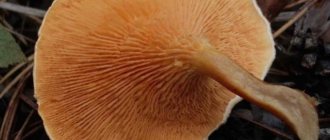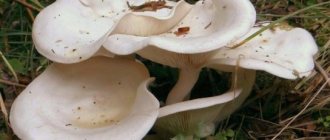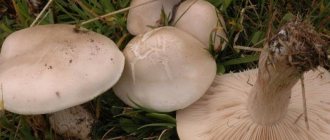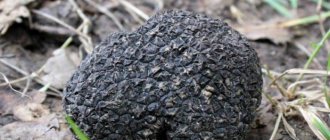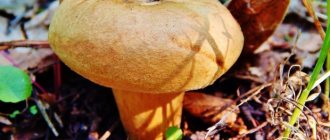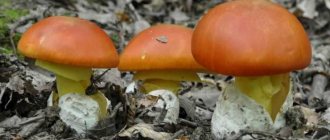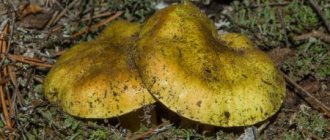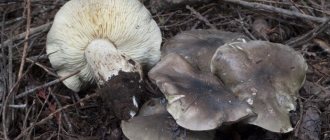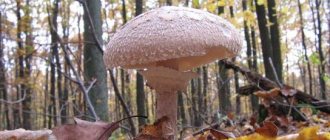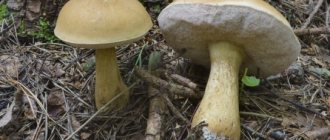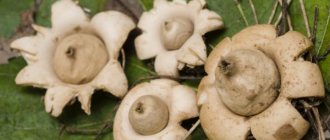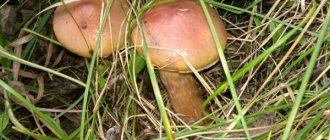Description of the whitish talker
The whitish talker has other names. So, it is called discolored, bleached, reddish, furrowed talker. If you come across one of these names in any literature, know that we are talking about the same fruit.
What does it look like
The mushroom does not have a special, specific appearance. It can be considered an ordinary white mushroom, which is found in abundance in forests and plantings. However, this fruit is not as harmless as it seems at first glance. In order not to accidentally put such a specimen in a basket with a mushroom harvest, you need to know about its main features.
Structure and features of the species
The main characteristics by which this specimen can be recognized are as follows:
- Hat. It reaches a diameter of 2-6 cm. In young specimens it is convex, and its edges are noticeably tucked downwards. With age, the fetal cap becomes prostrate, and at the end of the life cycle it acquires a concave or depressed shape. Often it has wavy edges. The color of the cap section can vary from powdery white or whitish-grayish to ocher. Light color is typical for young individuals, darker and richer for older fruits. If you look at the surface of the cap, you will notice that it is densely covered with a powdery coating, which is easily removed. In wet weather, the skin of the cap becomes slimy, and on dry days it is shiny and silky. When completely dry, it begins to crack and becomes noticeably lighter.
- The pulp can be called thin-fleshed. Its thickness on the disk of the cap part is only 3-4 mm. It feels fibrous to the touch, its structure is elastic. The color of the pulp is whitish; its color does not change when cut. The smell is mealy. The mushroom does not have an expressive taste.
- Leg. Its length is about 2-4 cm, and its thickness is from 0.4 to 0.6 cm in diameter. Its shape is cylindrical, the leg tapers noticeably towards the base. It can be completely straight or curved. Young mushrooms have a solid stem, but over time a cavity forms inside it. The foot surface is whitish or grayish in color, but in places it is covered with spots of a nut-colored color. If you press on it, it darkens.
Whitened govorushka belongs to the lamellar mushrooms. Its plates are frequent and whitish in color. As they mature, they take on a light yellow hue.
The spore powder is also white in color. The shape of the spores is ellipsoidal, their surface is smooth, and they themselves are colorless.
Edible or not?
Whitened govorushka is an inedible mushroom. Moreover, it belongs to the category of poisonous, deadly fruits.
Remember! It is strictly forbidden to eat it, even a small dose can be fatal!
Spreading
The talker is discolored.
The whitish talker can easily be found throughout the temperate forest zone. It grows in clearings, clearings, forest edges, and in forests of various types. Often settles next to honey mushroom colonies. Prefers places well lit by the sun. The whitish talker grows in groups, both small and numerous, throughout the summer and autumn, until the first frost.
Whitish talker (Clitocybe rivulosa)
Govorushka grooved
Whitish, bleached, or discolored talker (lat. Clitocybe dealbata), also reddish or grooved talker (lat. Clitocybe rivulosa) is a species of mushroom included in the genus Talker (Clitocybe) of the family Tricholomataceae.
The whitish talker grows on the soil or on the litter in places with grass cover - in meadows and pastures or on the edges, clearings and clearings in deciduous and mixed forests, as well as in parks. Fruiting bodies appear in groups, sometimes very large; form “witch circles”. Distributed in the temperate zone of the Northern Hemisphere. Season from mid-July to November.
The cap of the talker is whitish, ∅ 2-6 cm, in young mushrooms it is convex, with a rolled edge, later it is spread out, in old mushrooms it is flat or depressed, often with a wavy edge. The color of the cap varies from powdery white and whitish-grayish in young mushrooms to ocher in mature ones. Mature mushrooms have vague grayish spots on the cap. The surface of the cap is covered with a thin powdery coating, which is easily removed; in wet weather it is a little slimy, in dry weather it is silky and shiny; When dry, it cracks and becomes lighter.
The pulp is thin-fleshy (3-4 mm thick at the cap disk), elastic and fibrous, whitish, and does not change color when cut. The taste is inexpressive; the smell is mealy.
The leg of the whitish talker is 2-4 cm long and 0.4-0.6 cm ∅, cylindrical, slightly tapering towards the base, straight or curved, solid in young mushrooms, later hollow; the surface is whitish or grayish, in places covered with nut-colored spots, darkening when pressed, longitudinally fibrous. The plates are frequent, whitish, later grayish-whitish, in maturity they acquire a light yellow color, descending onto the stalk, 2 - 5 mm wide. Spore powder is white. Spores are 4-5.5 × 2-3 µm, ellipsoidal, smooth, colorless.
Deadly poisonous mushroom!
The muscarine content in the white fly agaric is higher than in the red fly agaric. Muscarine, contained in the fruiting bodies of the whitish talker (as well as in the fruiting bodies of related species, for example, Clitocybe phyllophila), can cause severe poisoning, which manifests itself 15-20 minutes after ingestion with increased secretion of saliva and tears, sweating, in large doses - weakening of the heart rate, a sharp decrease in blood pressure, breathing problems, severe vomiting and diarrhea. Symptoms of poisoning usually begin to subside within two hours. Fatalities are quite rare. The antidote for muscarine poisoning is atropine and other M-anticholinergic drugs.
It grows on soil or on litter in places with grass cover - in meadows and pastures or on edges, clearings and clearings in deciduous and mixed forests, as well as in parks. Fruiting bodies appear in groups, sometimes very large; form “witch circles”. Distributed in the temperate zone of the Northern Hemisphere.
Season from mid-July to November.
In the literature, two species were often distinguished: Clitocybe rivulosa with a pinkish cap and plates and a short stalk, and Clitocybe dealbata with a grayish color and a longer stalk. These factors turned out to be insufficient for separation; the color of hygrophanic talkers significantly depends on the degree of wetting. Molecular genetic studies also concluded that there is one polymorphic species.
Talking mushrooms can be edible or inedible, so when going into the forest, you need to clearly understand what one or another variety looks like. If you are not completely sure about the nutritional characteristics, it is better not to put such mushrooms in your basket. Below you will find photos and descriptions of waxy, bent, orandeva, funnel-shaped, cracking, club-footed and other types.
It is worth noting that most often only the caps of edible mushrooms are eaten, since the flesh of the stem has low taste and fibrous structure. In most cases, talker mushrooms are boiled and pickled.
Kinds
Previously in the literature, authors identified 2 types of poisonous talkers:
- Clitocybe rivulosa. Actually, this is the inedible specimen in question. It has the same parameters that were described earlier.
- Clitocybe dealbata. This breed of talker is distinguished by a longer leg and grayish color.
But it is worth noting that all the described characteristics obtained during mycological studies were not enough to divide the talker into these 2 varieties. Still, they have much more common characteristics than differences. In addition, after molecular tests it became obvious that these breeds belong to the same polymorphic type.
Talkers whitish, whitish and reddish-brown
White talker (Clitocybe candicans). The cap is 1.5–5 cm in diameter, convex at first, later straightened to concave, the edge is thin and drooping. The skin is at first slightly mealy, then shiny and smooth. The color is white, sometimes with a faint pink tint. The plates are frequent, slightly descending, white. The pulp is thin, white, the smell is inexpressive, the taste is pleasant.
The stem is 2–4 cm high, up to 0.5 cm in diameter, cylindrical, often bent at the base, tomentose. The color is white or yellowish.
Spore powder. White.
Habitat. In forests of various types on litter and needles.
Season. August – November.
Similarity. With other small white talkers, which you should refrain from collecting.
Use. The mushroom is suspicious, in different sources it is designated as poisonous, inedible, non-poisonous. According to some reports, it contains muscarine.
Whitish talker, whitened talker (Clitocybe dealbata). The cap is 2–4 cm in diameter, convex or flat, later funnel-shaped, often irregular in shape, with a sinuous, uneven edge. The skin is smooth, dry, with a slight powdery coating. The color is whitish, with faint grayish zones along the edge in the form of concentric circles formed when the plaque cracks, with buffy spots at maturity. The plates are adherent or descending, white or grayish, then cream. The pulp is thin, white, the taste is inexpressive, the smell is weak.
The stem is 2–4 cm high, up to 1 cm in diameter, cylindrical, slightly thickened towards the base, whitish or cream-colored, at first solid, later hollow.
Spore powder. White.
Habitat. In meadows, pastures, and forest grassy edges.
Season. Summer autumn.
Similarity. The mushroom is extremely similar to cherry (Clitopilus prunulus), which has a much stronger floury odor and whose blades acquire a pinkish tint when ripe.
Use. A very poisonous mushroom due to its high muscarine content.
Caution: if you have the slightest doubt, it is better to refuse to collect white talkers altogether.
Cracking talker, Reddish talker (Clitocybe rivulosa). The cap is 2–5 cm in diameter, convex at first, later straightens out, depressed in the center, covered with a powdery white coating, which cracks as the cap grows, revealing the main color – cream or reddish-reddish. As a result, the surface is covered with unclear concentric zones. The plates are adherent, frequent, reddish-white, later creamy. The pulp is thin, the taste is inexpressive, the smell is inexpressive.
The stem is 2–4 cm high, 0.4–0.8 cm in diameter, the same color as the cap or reddish-brown, slightly felt-like at the base.
Spore powder. White.
Habitat. In forests, gardens, parks, often along paths, along the sides of ditches.
Season. From late summer to autumn.
Similarity. With other small white talkers, with edible cherry (Clitopilus prunulus), which has a floury smell and pink leaves.
Use. The mushroom is very poisonous.
Caution: do not collect small white talkers if you are not sure of the exact definition.
The talker is red-brown. The cap is 5–9 cm in diameter, wide-funnel-shaped, red-yellow, reddish-brown or rusty-spotted, often hygrophanous. The plates are frequent, delapidating, cream or yellow-rusty. The pulp is thin, brittle, hard, reddish or fawn, the smell is sour, the taste is tart.
The leg is 3–5 cm high, up to 1 cm in diameter, reddish, lighter than the cap, hard.
Spore powder. White.
Habitat. In coniferous, less often deciduous forests.
Season. This is an autumn species that grows until frost persists.
Similarity. Similar to the waterspotted talker (C. gilva), growing in deciduous and coniferous forests, lighter in color and having watery spots on the surface; on the edible funnel talker (C. infundibuliformis), which has white plates.
Use. Previously, the red-brown talker and the water-spotted talker were considered edible, but later muscarine was discovered in them. Information in the literature about their edibility is very contradictory; moreover, their taste is mediocre, and therefore we do not recommend collecting these mushrooms.
Look at the photos of talker mushrooms, the description of which is presented on this page:
Large smooth Govorushka bent in the photo
Rare edible mushroom Govorushka orange in the photo
The whitish talker in the photo
Mushroom diets
In order to go on a mushroom diet, in which the daily diet will consist of nutrients and talkers, you need to know in advance how to cook these mushrooms. The cooking method is simple. Fruit bodies must be cleaned of leaves, debris and other forest contaminants.
Then you need to rinse the mushrooms under running cold water. Pour the required amount of water into the pan so that it completely covers the nutritious talkers and add salt (1 teaspoon per 1 liter). When the water boils, set aside for 25-30 minutes and cook over medium heat. After such processing and preparation, the mushroom can be used in any diet.
Losing excess weight with the help of a mushroom diet is simple; this is possible due to the low calorie content of talkers and their ability not to linger in the stomach. This food prevents fat deposits in the body. Nutritionists prescribe mushroom diets if there are no diseases of the kidneys, intestines, stomach or liver. This is due to the fact that the pulp contains a substance called chitin, which is difficult to digest. Therefore, it is best to consult with a specialist before testing a new diet.
A mushroom diet with vegetables will help you get rid of extra pounds in a short period of time. You need to eat 400 grams of talkers per day and the same amount of any vegetables. You need to eat mushrooms in three doses. You are allowed to drink mineral water, juices, green tea and a glass of rye kvass. For a variety of tastes, you are allowed to enjoy one or two teaspoons of honey. The results of the diet will be noticeable after one and a half to two weeks.
Best materials of the month
- Coronaviruses: SARS-CoV-2 (COVID-19)
- Antibiotics for the prevention and treatment of COVID-19: how effective are they?
- The most common "office" diseases
- Does vodka kill coronavirus?
- How to stay alive on our roads?
A mushroom diet, in which mushrooms completely replace meat and become the main ingredient of dishes.
Talkers inverted and anise
The talker is inverted (reverse lepista). The cap is 4-8 cm in diameter, as the mushroom grows it becomes wide-funnel-shaped, brick- or red-yellow-brown, fades over time, and is shiny in damp weather. The plates are frequent, descending to the stem, light yellow, then brownish-yellow, sandy-ochre. The pulp is thin, grayish-yellow or fawn, light brownish, with a faint sour odor. The stem is root-like at the base, often curved, rigid, solid, then hollow, reddish, usually lighter than the cap, or rusty-brown. The inverted talker can be found in pine forests and plantings on coniferous litter, in mixed forests on litter. Fruiting bodies form large groups in August–October.
Preparation. Low value edible mushroom. Suitable for pickling after boiling. Some authors classify this mushroom as inedible.
Anise talker is an edible lamellar mushroom. Other names are odorous talker and fragrant talker. A rather rare mushroom that grows singly or in small groups from early August to late October, producing large harvests each year. Most often it can be found in mixed and spruce forests.
When describing this talker, it is worth noting that its convex cap with downward-curved edges straightens as it grows and takes on an outstretched shape. In the center, as a rule, it has a small depression, less often a tubercle. The cap is painted gray-green, lighter around the edge.
The spore-bearing layer contains adherent plates, which are whitish in young mushrooms and pale green in mature ones. The leg is rounded, wider at the base, grayish-yellow in color with a greenish tint. Its height is approximately 5 cm with a diameter of no more than 0.5 cm. The surface of the stem of the cap is smooth, with slight pubescence at the base. The pulp is thin, watery, pale green or off-white in color, with a strong anise odor.
Anise talker belongs to the fourth category of mushrooms. It is eaten boiled, salted or pickled, and as a result of heat treatment, the characteristic smell of anise is significantly weakened and becomes less pronounced than that of fresh mushrooms.
How to distinguish from other mushrooms
Among the edible mushroom group, poisonous reddish and whitish talkers are distinguished by their paler color. They also have a sweetish-pleasant smell, which significantly distinguishes them from healthy ones: in meadow honey fungus it is more almond-like, while in honey mushroom it is more mealy.
The red talker can be distinguished by the flesh-colored fruiting body, a fleshier thick stem and a tubercle in the center of the cap. Camelina has a good mushroom aroma and a much brighter color.
Considering these features of talkers, we can conclude that it is better for not very experienced mushroom pickers to avoid clearings where strange mushrooms grow, so as not to risk their health and sometimes their lives.
Useful properties of hydrogen peroxide
The H2O2 compound is found naturally in rain and melt water, in mountain air, in fruits and vegetables. Peroxide molecules are “integrated” into the metabolic processes of living organisms and have a beneficial effect on them.
Useful properties of H2O2 solution for cucumbers and other garden crops:
- promotes saturation of soil and plant tissues with oxygen when spraying and watering;
- neutralizes organic pollutants, improves the quality of tap and well water, making its composition close to natural precipitation;
- participates in the formation of immunity, influencing the release of the enzyme peroxidase;
- increases germination, stimulates seed germination;
- disrupts the vital activity of pathogenic organisms;
- improves plant respiration and photosynthesis.
Contraindications
Edible species do not cause harm, but have a number of contraindications, if present, they should not be eaten. These include:
- pregnancy;
- breastfeeding period;
- presence of diarrhea;
- irritable bowel syndrome;
- indigestion and stomach acidity.
Talker mushrooms should not be given to children at an early age, because the active components contained in their composition can cause attacks of nausea and vomiting.
Edible species have some contraindications
Waterproofing foundation walls
Protection of walls from capillary moisture is achieved by installing horizontal adhesive waterproofing at a level above the blind area, coating waterproofing of the vertical surfaces of the walls of the basement (technical underground) in contact with the ground and laying a greasy cement-sand mortar in the preparation level under the floors of the basement (technical underground).
Horizontal waterproofing of 2 layers of waterproofing on bitumen mastic on a leveled surface should be carried out along the entire perimeter of the external and internal walls at a level above the blind area (and above the snow that melts in the spring).
Horizontal waterproofing from a layer of greasy cement mortar with a composition of 1:2 and a thickness of 20 mm should be carried out at a level below the basement floor.
Vertical waterproofing of basement walls, porches, and entrances to the basement in contact with the ground should be carried out by coating with hot bitumen 2 times.
Application
The presence of a huge number of diverse representatives of this species has led to their widespread use in agriculture and medicine.
In cooking
Talker mushrooms have a special taste, and their smell gives off fruity notes, but at the same time they are not very popular. Young mushrooms are used for cooking because... in old age they lose their taste. Only the caps are taken, the legs are not used at all. This mushroom is suitable for all types of homemade dishes and preparations. They perfectly complement soups and are often used as a base for sauces. The main thing to remember is that representatives of this genus are conditionally edible mushrooms and require preliminary heat treatment before further use. Mushrooms have a fibrous structure and, when boiled, lose more than half of their weight; this should also be taken into account when cooking. In numbers, this can be expressed as a ratio of 5:1, where the first number is what was before cooking, but the second is what remains after it. Only smoky (gray) govorushka is dried and salted.
In medicine
This type is not widely used in official medicine, because its representatives have not been fully studied, but traditional healers have long noticed the beneficial properties of this mushroom and began to use it for their own purposes. Talker mushrooms are used to make various decoctions and ointments that help disinfect wounds. Extracts from them are drunk for urolithiasis and pneumonia.
Storage and planting periods of treated seeds
After processing, the seeds are ready for planting. If cucumbers are grown in a greenhouse, then the treated seed is planted every other day in prepared, disinfected soil. If you plan to grow vegetables in outdoor soil, then you can plant the treated seeds only in sprouted form, when they form sprouts. If the shell is closed, the grains may not open under unfavorable conditions and will die from the cold.
Treated grains are unsuitable for long-term storage, otherwise all the beneficial qualities of the procedure simply disappear. There is a risk of infection, germination deteriorates, and mold appears on the protective shell from soaking over time. In the future, this will negatively affect the development of vegetables.
Hydrogen peroxide is an inexpensive way to get high-quality seed without a lot of effort. This method really works, and experienced summer residents continue to use it year after year, which only proves its high efficiency. Pre-planting treatment should not be neglected, since this is one of the important stages of cultivation, at which the health of future plants is determined.
It is recommended to use this product as a top dressing for picked seedlings. This helps her quickly settle into a new place and begin active growth. Seedlings can be treated once every 7-10 days.
Complications
Severe poisoning can occur in children, or if it occurs against the background of alcohol intoxication. Complications of talker poisoning are:
- breathing problems;
- cardiac dysfunction, drop in blood pressure;
- aspiration of vomit, which increases bronchospasm, and in the future can lead to pneumonia.
The prognosis for poisoning with waxy or pale talker, if help is provided in a timely manner, is favorable. The patient's condition quickly improves after removing muscarine from the blood and he can be discharged home within 2–3 days.
Correctly prepare seeds and fertilize seedlings
| Disinfect planting material Prepare a solution in a ratio of 1:10. Add 20 g of the composition to a glass of water, after which the liquid must be mixed well. Wrap the seeds in a bandage or gauze to make them easier to remove after processing. Dip into liquid and soak for about 20 minutes. Remove and rinse the seeds in warm water. You can dry them a little | |
| Soak to stimulate growth Prepare a solution of a tablespoon of peroxide per glass of water. Mix well and dip the seeds in gauze or cloth. Leave for approximately 12 hours. After this, you can either sow the seeds or place them in a container for further germination. | |
| Spray approximately once a week Prepare a solution at the rate of 30 ml of peroxide per liter of water. This is the optimal concentration for use on seedlings. Spray the ground part about once a week. Use a household sprayer to distribute moisture evenly throughout all leaves and stems | |
| Water the seedlings with a solution of hydrogen peroxide Prepare the solution in the same concentration as for spraying. Mix the liquid well and use it immediately after preparation. Carry out work no more than once a week. Replace regular watering, add the same amount of water as usual | |
| Water the seedlings immediately after planting After planting cucumbers in a greenhouse or open ground, instead of water, it is better to water them with a solution with peroxide. Make a 3% version before use. Pour at least a liter onto each plant. This stimulates rapid adaptation and development of the root system |
You need to prepare before soaking cucumber seeds in hydrogen peroxide before planting. To do this, the following preparatory steps are carried out:
- the seeds are pre-soaked in ordinary cool water for 30 minutes to soften the protective shell;
- dilute a working solution consisting of tbsp. 3% pharmaceutical peroxide solution and 500 ml of water.
You may be interested in:
First aid for poisoning
At the first symptoms of talker poisoning, you need to call an ambulance. The antidote for muscarine is atropine. If possible, an atropine injection is given to prevent the development of poisoning. When this is not possible, then the victim must be laid down before the ambulance arrives.
The patient should not be given any antiemetic drugs or medications for diarrhea - the body must be cleansed of the poison. During poisoning, vomiting occurs spontaneously, this is a symptom. You can independently provoke vomiting by irritating the root of the tongue with your fingers, but you should not drink water for this purpose, as it will enhance the absorption of the poison. It is better to let the patient take activated charcoal or any other sorbent.
If the patient has lost consciousness, you need to lay him on his side to prevent vomit from entering the respiratory tract. During convulsions, make sure that the patient does not hit furniture or surrounding objects. There is no need to give the patient water or do an enema, as this can enhance the absorption of muscarine into the blood and worsen the patient’s condition.
If breathing stops, resuscitation measures are carried out - artificial respiration and indirect cardiac massage.
Features of the effects of hydrogen peroxide
Hydrogen peroxide (hydrogen peroxide) is a colorless substance with a “metallic” taste that is of natural origin. It is found in precipitation and is a by-product of the oxidation of various substances by air. Contained in mountain air.
The substance has a bactericidal effect due to its chemical properties. Easily enters into an oxidation reaction, for example, with protein compounds, releasing water. When reacting with other oxidizing agents, it is a reducing agent; the reaction occurs with the release of atomic oxygen. In small concentrations, hydrogen peroxide is unstable and easily decomposes into water and oxygen molecules.
Benefit
How does the beneficial effect of peroxide manifest itself:
- due to its oxidative effect, it destroys the tissues of pathogens and pests on plants and in the soil;
- watering promotes soil aeration due to the instability of the substance;
- The quality of tap water improves, because reacts with organic matter and pesticides.
Treatment of poisoning
The patient must be taken to a hospital, usually to the intensive care unit. On the way to the hospital, the patient is given atropine (0.1 gram is enough). Atropine is an anticholinergic blocker that relieves irritation of M-receptors. Then measures are taken to remove muscarine from the body and support the activity of the heart and breathing.
To remove muscarine, gastric lavage is done and castor oil or an enema is prescribed. If the patient’s consciousness is confused, then infusion therapy is performed, this is the intravenous administration of medicinal solutions in large volumes. Then Furosemide (aka Lasix) is prescribed so that excess water is excreted in the urine and removes the remaining muscarine in the blood. This treatment method is called forced diuresis.
In case of cardiac dysfunction, camphor and caffeine are prescribed, and in case of shortness of breath or decreased breathing volume, the patient is given oxygen to breathe. In severe cases, pulmonary intubation may be necessary.
Where does it grow?
This mushroom grows in mixed, coniferous and deciduous forests. Also found in pastures, clearings and forest edges. They are collected in the Caucasus and the European part of Russia. Basically, these mushrooms can be found in large quantities, as they grow in groups.
Every year, the giant talker is capable of providing a large harvest, but the mushroom picker does not encounter them too often. When growing, the giant talker mainly makes up “witch’s rings”. These mushrooms can be collected from August to October. Young mushrooms have spread-convex caps with a depression in the center. Over time, the caps become funnel-shaped with a thin edge curved down. The shades of the caps are usually yellowish, creamy, snow-white, and sometimes take on a “coffee with milk” hue. The size of the mushroom cap reaches 10-15 cm and even 30 cm in diameter. The pulp has a floury smell and practically no taste. It is dense and white. The plates descend to the stem, being descending. They are narrow, light ocher in color, tightly spaced. The leg is white, up to 4 cm wide and 8 cm long. This mushroom is conditionally edible, and for this reason it should first be boiled, and only then start cooking. The pulp of the mushroom contains: clitocybin A and B and an antibiotic that destroys the tuberculosis bacillus. Cliptobicin is extracted from mushrooms, which is an antimicrobial agent used to treat tuberculosis of bones and skin. A useful property of this mushroom is that giant talker contains physiologically active elements used as producers of growth and antibiotic substances. Talkers are beneficial for the body, as they provide prevention of infectious diseases. Digestion is improved thanks to enzymes that help the human body get rid of toxins and the functioning of the stomach improves. In addition, talkers reduce the amount of cholesterol in the blood. In folk medicine they are used to treat urolithiasis and respiratory tract diseases, as well as to heal wounds (ointments and decoctions). Contraindications: there is information that when combining talkers with alcohol, a person may experience body poisoning.
Popular articles Symptoms of chanterelle mushroom poisoning
Interesting Facts
- The yellow-brown row is unremarkable, but is capable of growing in drought conditions, even when there are no other mushrooms.
- Antidiabetic drugs have been created based on extracts from this type of mushroom.
- The calorie content of the product is very low, only 20 kcal per 100 grams.
- The film must be removed from the row caps, so they will taste less bitter when cooked.
- Rowing can be grown at home. In Europe it is considered a delicacy.
Although the yellow-brown row is considered an edible species, it requires extreme care during collection and processing. You should remember about personal safety measures and do not collect mushrooms whose quality you are not sure of.
